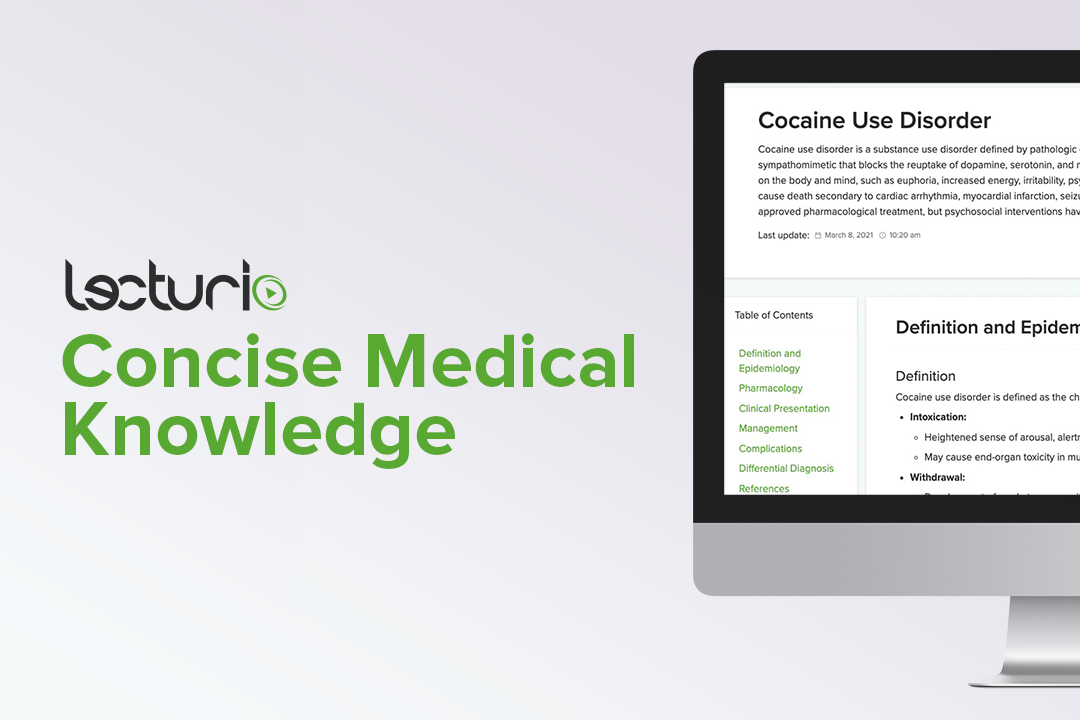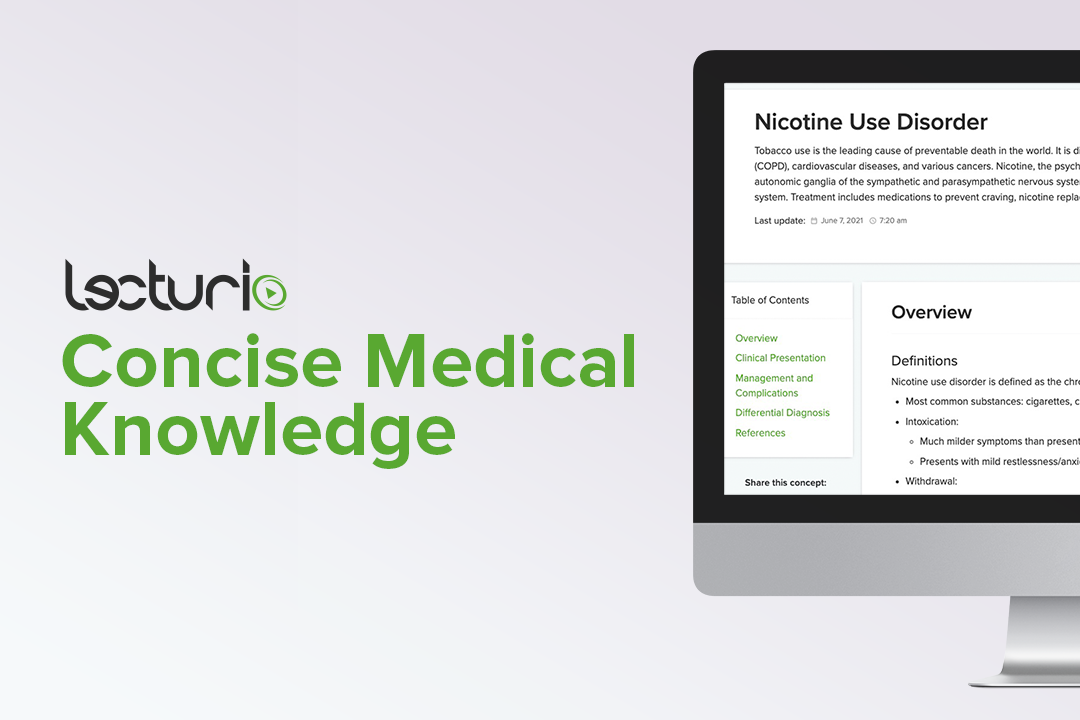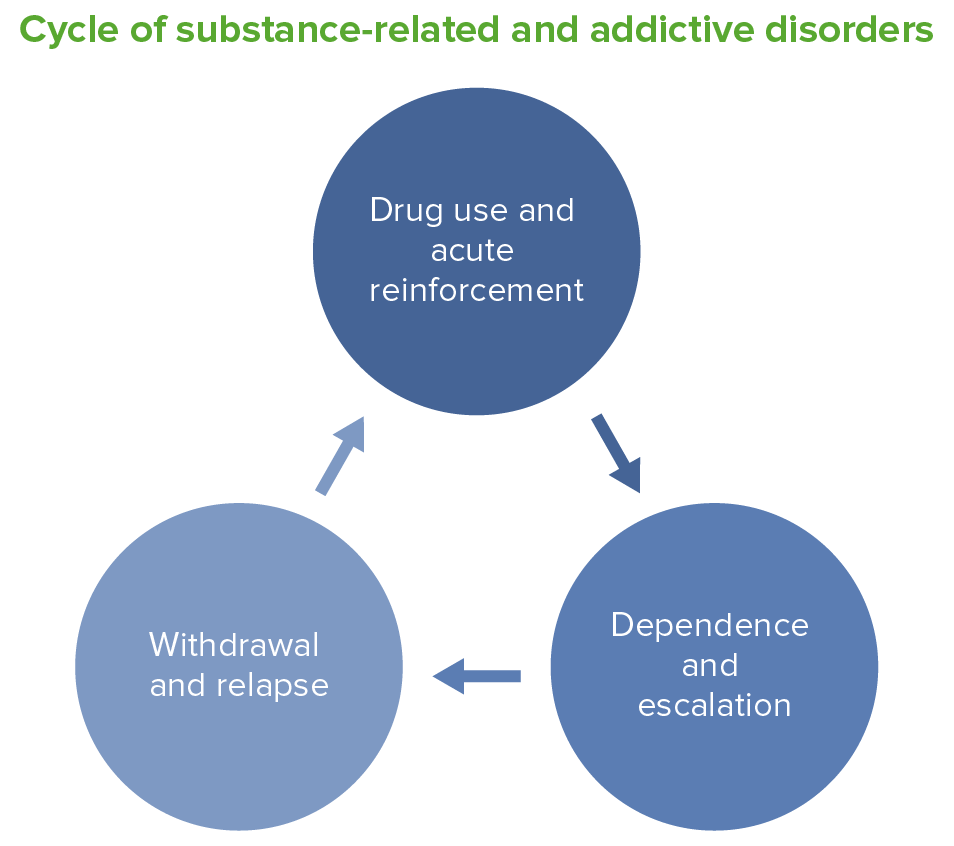Playlist
Show Playlist
Hide Playlist
Substance-related Disorders and Addictive Disorders
-
Slides Other Substances.pdf
-
Download Lecture Overview
00:01 Let's talk now about some other substance related disorders, starting with Marijuana. 00:07 So the main active component in marijuana is THC and assessment for marijuana consists of urine drug screenings and it will actually stay positive for about 4 weeks after use. 00:21 Some of the assessment signs are gonna be seeing a patient who seems euphoric. 00:27 They may have impaired coordination during times of marijuana intoxication, fast heartbeat or tachycardia, conjunctival injection which is really a key marker for marijuana intoxication, dry mouth, and increased appetite. During the withdrawal phase of marijuana, patient may present with irritability, insomnia, nausea, and decreased appetite. 00:51 So, I wanna talk a little bit about amotivational syndrome and what this is. 00:58 So, amotivational syndrome is really associated with cannabis abuse and it's characterized by an unwillingness to participate in tasks that require prolonged attention. So this can be seen in somebody who's really a chronic user of marijuana and they really are unwilling to engage in things that are going to require a lot of attention and focus. Moving on now to caffeine, a very highly abused substance. So, intoxication with caffeine look like the following: anxiety, insomnia, twitching, rambling speech, flushed face, diuresis, GI disturbance, and also restlessness. Some results of caffeine consumption over 1 gram, so a huge amount of caffeine, can result in tinnitus, sever agitation, and it can actually cause a cardiac arrhythmia. In extreme cases of caffeine consumption, the symptoms can also include seizures and respiratory failure. 02:04 Some of the symptoms of withdrawal from caffeine include headache, nausea and vomiting, drowsiness, anxiety, and actually, depression. And usually, caffeine withdrawal will begin in within 24 hours of its last use and it will peak within about 2 days. 02:24 The good news is, for people hoping to get off of caffeine, coffee, soda, whatever, usually withdrawal will remit after about a week and then, the person basically resets and no longer has any of these undesirable symptoms. 02:39 Now, let's talk about nicotine, another very highly abused substance. 02:44 Nicotine addiction is very prominent in other mental health disorders. 02:49 So it's often seen in patients who have schizophrenia, depression, anxiety, the lifetime prevalence of nicotine addiction is actually 20%, so it's very high and two of the most common causes of death associated with nicotine are actually cardiovascular disease, which could be stroke or heart attack, and lung disease in the form of COPD, cancer, or pneumonia. 03:15 So very serious consequences with this substance. And a little bit more about nicotine. 03:23 So of course it's derived from the tobacco plant. It stimulates nicotinic receptors in the autonomic ganglia of the sympathetic and parasympathetic nervous systems. 03:34 It's highly, highly addictive because of its work through the dopaminergic system. 03:41 So when somebody say, takes a hit of nicotine through smoking or what not, they get a surge of dopamine release and then this is what drives them to keep smoking so they can keep releasing dopamine and it becomes very addictive. 03:58 During the intoxicated state with nicotine, people can appear restless, they can have insomnia, anxiety, and GI upset. They can also have cravings, dysphoria, anxiety, increased appetite, irritability, and insomnia, again. So, health and cognitive problems that come along, what kind of things can you think about that put people, especially children of smoking parents, at risk. So, children in a home with a smoking parent are gonna be at particular risk for developing otitis media, pneumonia, asthma, sudden infant death syndrome, they'll have a low birth weight, low performance on standardized tests, and also poorer athletic performance. 04:49 So there are a lot of drawbacks to that second-hand smoke especially, when it's a child who's incurring the second-hand smoke. Treatment options for nicotine include behavioral counseling, replacement through gum or a patch, and also other medications like clonidine, bupropion, and varenicline. 05:10 Cocaine is a commonly abused substance and this works by blocking dopamine uptake from the synaptic cleft causing a stimulant effect in patients. 05:22 And dopamine plays a critical role in the brain's reward system, a very important point because this really is what drives addictions. 05:31 During cocaine intoxication, a patient may appear euphoric, have changes to their blood pressure and heart rate, they may have some nausea, you'll see dilated pupils, a very important point to remember, weight loss, and sometimes psychomotor changes. They can also have chills, respiratory problems, sweating, seizures, arrhythmias, and hallucinations. So, when you're meeting somebody who's testing positive for cocaine and they seem to be in the intoxicated state because they're still euphoric, you really do wanna monitor them closely for an arrhythmia by checking an EKG, you might monitor them closely for seizure disorder, maybe even check an EEG, and you wanna screen them for psychiatric symptoms as well. 06:17 Cocaine's vasoconstrictive effect may result in a myocardial infarction or cerebrovascular accident. 06:26 So paying close attention to their cardiac system is very, very important because cocaine use can actually lead to death through these things. 06:37 How long do you think the urine drug screen stays positive for cocaine after use? Well, the answer is 3 days, so, for a while. And do you know any street names that are used for cocaine? Here are a few, just to keep in mind. 06:54 The causes of death from cocaine use include a myocardial infarction, cerebral vascular accident, and the Pneumothorax. 07:05 Here's a question for you. 07:09 Which of the following treatments here is for cocaine dependence? So take a moment and look over these treatments and if you guessed psychotherapy and group therapy, you're exactly right. So, the long term treatment for a dependency problem is really going to be psychotherapy and support through peers. 07:30 However, if you're in the emergency room or in acute care setting and you encounter a patient who is intoxicated on cocaine, they're probably going to benefit from some of the following. 07:42 So, because they're overly excited and euphoric, benzodiazepines might be helpful in the very short term to help calm them down. 07:50 They also are going to need some symptomatic support. They're going to need to be hydrated, you're going to have to check their vital signs, always make sure their ABC's are under control, and monitor them on an EKG for a cardiac arrhythmia. 08:03 The patient is also gonna respond positively to Haloperidol which is an anti-psychotic and this can be used in the patient who's having hallucinations during the period of intoxication, especially if those hallucinations are at all dangerous such as command auditory hallucinations, telling the patient to harm themselves or others, and then eventually as the patient comes down from their intoxication, they're gonna start to withdraw from the cocaine and they're really gonna experience what's called a crash and this is gonna look like hypersomnolence and the best thing you can do for your patient is really to let them sleep off that crash.
About the Lecture
The lecture Substance-related Disorders and Addictive Disorders by Helen Farrell, MD is from the course Control Disorders. It contains the following chapters:
- Marijuana
- Caffeine
- Nicotine
- Cocaine
Included Quiz Questions
Which of the following is a key sign of marijuana abuse?
- Conjunctival injection
- Mild tachycardia
- Dry mouth
- Euphoria
- Increased appetite
What is the main active component in marijuana?
- Tetrahydrocannabinol
- Cocaine hydrochloride
- Methylenedioxypyrovalerone
- Methylenedioxymethamphetamine
- Lysergic acid diethylamide
Which of the following is NOT seen in caffeine intoxication?
- Weight gain
- Insomnia
- Anxiety
- Flushed face
- Cardiac arrhythmia
Which of the following is FALSE regarding caffeine withdrawal?
- The patient shows symptoms of mania
- Withdrawal can cause headache, nausea, vomiting and drowsiness
- The symptoms begin within 24 hours of its last use
- The symptoms peak at 24–48 hours
- Resolves in approximately a week
Which of the following is FALSE about nicotine?
- Stomach cancer is the most common cause of death associated with nicotine
- The lifetime prevalence of nicotine addiction is 20%
- Nicotine stimulates the autonomic ganglia of sympathetic and parasympathetic nervous systems
- Addiction is due to the involvement of the dopaminergic system
- Children with second hand smoking are at risk for otitis media, SIDS and low birth weight
Which of the following is TRUE about cocaine abuse?
- Cocaine blocks dopamine uptake from the synaptic cleft causing a stimulant effect
- A patient on cocaine appears sober and depressed
- Cocaine’s vasoconstricting effect results in renal ischemia and death
- Cocaine test stays positive 1 week after use
- Cocaine is protective against the development of myocardial infarction
When a crash occurs during cocaine withdrawal, how should it be managed?
- Rest and sleep
- Low dose benzodiazepines
- Psychotherapy
- High dose haloperidol
- IV fluids through a large bore needle
Customer reviews
5,0 of 5 stars
| 5 Stars |
|
5 |
| 4 Stars |
|
0 |
| 3 Stars |
|
0 |
| 2 Stars |
|
0 |
| 1 Star |
|
0 |






